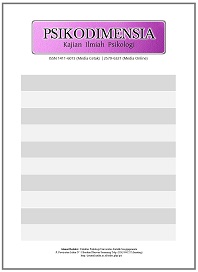Hubungan Antara Self-Compassion dan Regulasi Emosi dengan Stres pada Dewasa Awal
Abstract
Dewasa awal rentan dengan stres, terkait tuntutan banyak peran yang dimiliki, serta situasi yang menuntut dan terus berubah pada masa tersebut. Stres pada dewasa awal meningkatkan risiko gangguan kesehatan fisik dan mental, serta kinerja individual dan sosial seseorang. Penelitian ini bertujuan mengetahui korelasi self-compassion dan regulasi emosi terhadap stres dewasa awal. Subjek adalah 124 orang mahasiswa yang masih aktif kuliah dan berusia 18-30 tahun. Teknik sampel yang dinguanakan adalah incidental sampling. Alat ukur yang digunakana adalah Perceived Stress Scale 10 (PSS-10), Self-Compassion Scale (SCS), dan Emotion Regulation Questionnaire (ERQ), yang kemudian dianalisis menggunakan analisis regresi linier berganda. Penelitian ini menemukan bahwa terdapat hubungan yang sangat signifikan antara self-compassion dan regulasi emosi dengan stres dewasa awal (R = 0,697 dan p<0,01), ada hubungan negatif yang sangat signifikan antara self-compassion dengan stres pada dewasa awal (r = -0,627 dan p<0,01), serta terdapat hubungan negatif yang sangat signifikan antara regulasi emosi dengan stres pada dewasa awal (r = -0,565 dan p<0,01). Kesimpulan penelitian adalah self-compassion dan regulasi emosi berhubungan dengan stres pada dewasa awal.
Keywords
Full Text:
PDF (Bahasa Indonesia)References
Afnan, Fauzia, R., & Tanau, M. U. (2020). Hubungan Efikasi Diri dengan Stress pada Mahasiswa yang Berada dalam Fase Quarter Life Crisis. Jurnal Kognisia, 3(1), 23–29.
Agarwal, S., Guntuku, S. C., Robinson, O. C., Dunn, A., & Ungar, L. H. (2020). Examining the Phenomenon of Quarter-Life Crisis Through Artificial Intelligence and the Language of Twitter. Frontiers in Psychology, 11, 1–11. https://doi.org/10.3389/fpsyg.2020.00341
Ahmad, A., Hussain, A., Mahmood, A., Ahmad, A., Ikram, A., & Yasmin, S. (2021). Quantifying the Consequences of Perceived Stress in the Textile and Clothing Sector through Structural Equation Modelling. Hindawi: Mathematical Problems in Engineering. https://doi.org/10.1155/2021/5597111
Aldao, A. (2013). The Future of Emotion Regulation Research: Capturing Context. Perspectives on Psychological Science, 8(2), 155–172. https://doi.org/10.1177/1745691612459518
Allen, A. B., & Leary, M. R. (2010). Self-Compassion, Stress, and Coping. Social Personaly Psychology Compassion, 4(2), 107–118. https://doi.org/10.1111/j.1751-9004.2009.00246.x.Self-Compassion
American Psychological Association (APA). (2018). Stress effects on the body. American Psychological Association (APA). https://www.apa.org/topics/stress/body
Arch, J. J., Brown, K. W., Dean, D. J., Landy, L. N., Brown, K. D., & Laudenslager, M. L. (2014). Self-compassion training modulates alpha-amylase, heart rate variability, and subjective responses to social evaluative threat in women. Psychoneuroendocrinology, 42, 49–58. https://doi.org/10.1016/j.psyneuen.2013.12.018
Barnard, L. K., & Curry, J. F. (2011). Self-Compassion: Conceptualizations, Correlates, & Interventions. Review of General Psychology, 1–15. https://doi.org/10.1037/a0025754
Bluth, K., & Eisenlohr-Moul, T. A. (2017). Response to a Mindful Self-Compassion Intervention in Teens: A Within-person Association of Mindfullness, Self-Compassion, and Emotional Well-Being Outcomes. Journal of Adolescence, 57, 108–118. https://doi.org/10.1016/j.adolescence.2017.04.001.Response
Bluth, K., Roberson, P. N. E., Gaylord, S. A., Faurot, K. R., Grewen, K. M., Arzon, S., & Girdler, S. S. (2016). Does Self-Compassion Protect Adolescents from Stress? Journal of Child and Family Studies, 25, 1098–1109. https://doi.org/10.1007/s10826-015-0307-3
Breines, J. G., McInnis, C. M., Kuras, Y. I., Thoma, M. V., Gianferante, D., Hanlin, L., Chen, X., & Rohleder, N. (2015). Self-compassionate young adults show lower salivary alpha-amylase responses to repeated psychosocial stress. Self and Identity, 14(4), 390–402. https://doi.org/10.1080/15298868.2015.1005659
Breines, J. G., Thoma, M. V., Gianferante, D., Hanlin, L., Chen, X., & Rohleder, N. (2014). Self-compassion as a predictor of interleukin-6 response to acute psychosocial stress. Brain, Behavior, and Immunity, 37, 109–114. https://doi.org/10.1016/j.bbi.2013.11.006
Cohen, S., Kamarck, T., & Mermelstein, R. (1983). A global measure of perceived stress. Journal of Health and Social Behavior, 24(4), 385–396. https://doi.org/10.2307/2136404
Cohen, S., Kessler, R. C., & Gordon, L. U. (Eds.). (1997). Measuring Stress: A Guide for Health and Social Scientist. Oxford University Press.
Denson, T. F., Creswell, J. D., Terides, M. D., & Blundell, K. (2014). Cognitive reappraisal increases neuroendocrine reactivity to acute social stress and physical pain. Psychoneuroendocrinology, 49(1), 69–78. https://doi.org/10.1016/j.psyneuen.2014.07.003
Devi, C. B. P., Reddy, A. M., Zahan, O., & Sharma, J. (2019). The effect of stress on humsn lifr. Adalya Journal, 8(9), 792–811. https://doi.org/10.1176/appi.psychotherapy.1972.26.4.588
Finlay-Jones, A. L., Rees, C. S., & Kane, R. T. (2015). Self-Compassion, emotion regulation and stress among australian psychologists: Testing an emotion regulation model of self-compassion using structural equation modeling. PLoS ONE, 1–19. https://doi.org/10.1371/journal.pone.0133481
Germer, C. K. (2009). The Mindful path to self-compassion. In Guilford. Guilford.
Germer, C. K., & Neff, K. D. (2013). Self-compassion in clinical practice. Journal of Clinical Psychology, 69(8), 856–867. https://doi.org/10.1002/jclp.22021
Gratz, K. L., & Roemer, L. (2004). Multidimensional assessment of emotion regulation and dysregulation: Development, factor structure, and initial validation of the difficulties in emotion regulation scale. Journal of Psychopathology and Behavioral Assessment, 26(1), 41–54. https://doi.org/10.1007/s10862-008-9102-4
Gross, J. J. (2002). Emotion Regulation: Affective, Cognitive and Social Consequences. Psychophysiology, 39, 281–291. https://doi.org/10.1002/9780470177334.ch3
Gross, J. J. (2014). Emotion Regulation: Conceptual and Empirical Foundations. In J. J. Gross (Ed.), Handbook of Emotion Regulation (pp. 3–19). Guilford.
Gross, J. J., & John, O. P. (2003). Individual Differences in Two Emotion Regulation Processes: Implications for Affect, Relationships, and Well-Being. Journal of Personality and Social Psychology, 85(2), 348–362. https://doi.org/10.1037/0022-3514.85.2.348
Gunawan, A., & Bintari, D. R. (2021). Kesejahteraan Psikologis, Stres, dan Regulasi Emosi pada Mahasiwa Baru Selama Pandemi Covid-19. Jurnal Penelitian Dan Pengukuran Psikologi, 10(1), 51–64. http://doi.org/10.21009/JPPP
Gyurak, A., Gross, J. J., & Etkin, A. (2011). Explicit and implicit emotion regulation: A Dual-Process Framework. Cognition Emotion, 25(3), 400–412. https://doi.org/10.1093/scan/nsx096
Joshi, R., & Joshi, P. (2021). Association of Optimism and Perceived Stress among Young Adults. The International Journal of Indian Psychology, 9(2), 1–11. https://doi.org/10.25215/0902.207
Kadi, A. R., Bahar, H., & Sunarjo, I. S. (2020). Hubungan antara Regulasi Emosi dengan Stres Akademik pada Mahasiswa Fakultas Kedokteran Universitas Halu Oleo. SUBLIMAPSI, 1(2), 85–94.
Katana, M., Röcke, C., Spain, S. M., & Allemand, M. (2019). Emotion regulation, subjective well-being, and perceived stress in daily life of geriatric nurses. Frontiers in Psychology, 10, 1–11. https://doi.org/10.3389/fpsyg.2019.01097
Langer, K., Hagedorn, B., Stock, L.-M., Otto, T., Wolf, O. T., & Jentsch, V. L. (2020). Acute stress improves the effectivity of cognitive emotion regulation in men. Scientific Reports, 10, 1–13. https://doi.org/10.1038/s41598-020-68137-5
Lazarus, R. S., & Folkman, S. (1984). Stress, Appraisal, and Coping. Springer.
Lee, E. H. (2012). Review of the psychometric evidence of the perceived stress scale. Asian Nursing Research, 6, 121–127. https://doi.org/10.1016/j.anr.2012.08.004
Lee, J., Kim, E. Y., & Wachholtz, A. (2016). The effect of perceived stress on life satisfaction: the mediating effect of self-efficacy. Chongsonyonhak Yongu, 23(10), 29–47. https://doi.org/10.21509/KJYS.2016.10.23.10.29.The
Liu, X., Zhao, Y., Li, J., Dai, J., Wang, X., & Wang, S. (2020). Factor Structure of the 10-Item Perceived Stress Scale and Measurement Invariance Across Genders Among Chinese Adolescents. Frontiers in Psychology, 11, 1=10. https://doi.org/10.3389/fpsyg.2020.00537
Mental Health Foundation. (2018). Results of the Mental Health Foundation’s 2018 Study. https://www.mentalhealth.org.uk/explore-mental-health/statistics/stress-statistics#:~:text=51%25 of adults who felt,had suicidal thoughts and feelings
Muttaqin, D., Yunanto, T. A. R., Fitria, A. Z. N., Ramadhanty, A. M., & Lempang, G. F. (2020). Properti psikometri Self-Compassion Scale versi Indonesia: Struktur faktor, reliabilitas, dan validitas kriteria. Persona:Jurnal Psikologi Indonesia, 9(2), 189–208. https://doi.org/10.30996/persona.v9i2.3944
Neff, K. (2003). Self-Compassion: An Alternative Conceptualization of a Healthy Attitude Toward Oneself. Self and Identity, 2, 85–101. https://doi.org/10.1080/15298860390129863
Neff, K. D. (2003). The Development and Validation of a Scale to Measure Self-Compassion. Self and Identity, 2(3), 223–250. https://doi.org/10.1080/15298860309027
Neff, K. D., Tóth-Király, I., Yarnell, L. M., Arimitsu, K., Castilho, P., Ghorbani, N., Hirsch, J. K., Hupfeld, J., Hutz, C. S., Kotsou, I., Lee, W. K., Montero-Marin, J., Sirois, F. M., Souza, L. K. de, Svendsen, J. L., Wilkinson, R. B., & Mantzios, M. (2019). Examining the Self-Compassion Scale in 20 Diverse Samples: Support for Use of a Total Score and Six Subscale Scores. Psychology Assessment, 31(1), 27–45. https://doi.org/10.1037/pas0000629.supp
Ogden, J. (2004). Health Psychology a Textbook (Third). McGraw-Hill Education.
Permono, J. W., & Kusristanti, C. (2016). Olahraga Dan Regulasi Emosi: Sebuah Studi Korelasi Pada Taruna Perguruan Tinggi Kedinasan (PTK). Jurnal Psikologi Ulayat, 3(2), 169–180. https://doi.org/10.24854/jpu22016-70
Rachmawati, A., & Cahyanti, I. Y. (2021). Strategi Regulasi Emosi terhadap Stres Akademis selama Menjalani Kuliah Daring di Masa Pandemi Covid-19. Buletin Riset Psikologi Dan Kesehatan Mental (BRPKM), 1(1), 96–103. https://doi.org/10.20473/brpkm.v1i1.24653
Richardson, C. M. E. (2017). Emotion regulation in the context of daily stress: Impact on daily affect. Personality and Individual Differences, 112, 150–156. https://doi.org/10.1016/j.paid.2017.02.058
Rusmaladewi, Indah, D. R., Kamala, I., & Anggraini, H. (2020). Regulasi emosi pada mahasiswa selama proses pembelajaran daring di program studi PG-PAUD FKIP UPR. Jurnal Pendidikan Dan Psikologi Pintar Harati, 16(2), 33–46.
Saedpanah, D., Salehi, S., & Moghaddam, L. F. (2016). The effect of emotion regulation training on occupational stress of critical care nurses. Journal of Clinical and Diagnostic Research, 10(12), 1–4. https://doi.org/10.7860/JCDR/2016/23693.9042
Santrock, J. W. (2011). Life-Span Develompment: Perkembangan Masa Hidup (Ketiga Bel). PT Erlangga.
Sarafino, E. P., & Smith, T. W. (2011). Health Psychology: Biopsychosocial Interactions (Seventh). John Wiley and Sons, Inc.
Schall, M., & Schütz, A. (2019). Emotion-regulation knowledge predicts perceived stress early but not later in soldiers’ careers. Journal of Workplace Behavioral Health, 1–13. https://doi.org/10.1080/15555240.2019.1573688
Seedhom, A. E., Kamel, E. G., Mohammed, E. S., & Raouf, N. R. (2019). Predictors of Perceived Stress among Medical and Nonmedical College Students, Minia, Egypt. International Journal of Preventive Medicine, 6(18), 1–6. https://doi.org/10.4103/ijpvm.IJPVM
Sugianto, D., Suwartono, C., & Sutanto, S. H. (2020). Reliabilitas dan Validitas Self-Compassion Scale Versi Bahasa Indonesia. Jurnal Psikologi Ulayat, 10(10), 1–16. https://doi.org/10.24854/jpu02020-337
Suwartono, C., & Bintamur, D. (2019). Validation of the Emotion Regulation Questionnaire (ERQ): Network Analysis as an Alternative of Confirmatory Factor Analysis (CFA). ANIMA Indonesian Psychological Journal, 34(3), 115–124. https://doi.org/10.24123/aipj.v34i3.2300
Thompson, R. A. (1994). Emotion Regulation: a Theme in Search of Definition. Monographs of the Society for Research in Child Development, 59(2–3), 25–52. https://doi.org/10.1111/j.1540-5834.1994.tb01276.x
Umberson, D., Williams, K., Powers, D. A., Liu, H., & Needham, B. (2005). Stress in childhood and adulthood: Effects on marital quality over time. Journal of Marriage and Family, 67(5), 1332–1347. https://doi.org/10.1111/j.1741-3737.2005.00220.x
Wang, M., & Saudino, K. J. (2011). Emotion Regulation and Stress. Journal of Adult Development, 18, 95–103. https://doi.org/10.1007/s10804-010-9114-7
Widodo, R. I. (2018). Periode Dewasa Muda Jadi Masa Paling Stres. Harian Republika. https://www.republika.co.id/berita/gaya-hidup/trend/18/03/16/p5nxu5328-periode-dewasa-muda-jadi-masa-paling-stres
Worku, D., Dirriba, A. B., Wordofa, B., & Fetensa, G. (2020). Perceived Stress, Depression, and Associated Factors among Undergraduate Health Science Students at Arsi University in 2019 in Oromia, Ethiopia. Hindawi Psychiatry Journal, 1–8. https://doi.org/10.1155/2020/4956234
Yuniaty, S., & Hamidah. (2019). Pengaruh Perceived Stress dan Religiusitas terhadap Intensi Bunuh Diri Dewasa Awal. INSAN Jurnal Psikologi Dan Kesehatan Mental, 4(1), 1–10. https://doi.org/10.20473/jpkm.v4i12019.1-10
Zahniser, E., & Conley, C. S. (2018). Interactions of emotion regulation and perceived stress in predicting emerging adults’ subsequent internalizing symptoms. Motivation and Emotion, 1–11. https://doi.org/10.1007/s11031-018-9696-0
DOI: https://doi.org/10.24167/psidim.v22i1.5018
Print ISSN : 1411-6073 | online ISSN : 2579-6321 View My Stats

This work is licensed under a Creative Commons Attribution 4.0 International License.




















